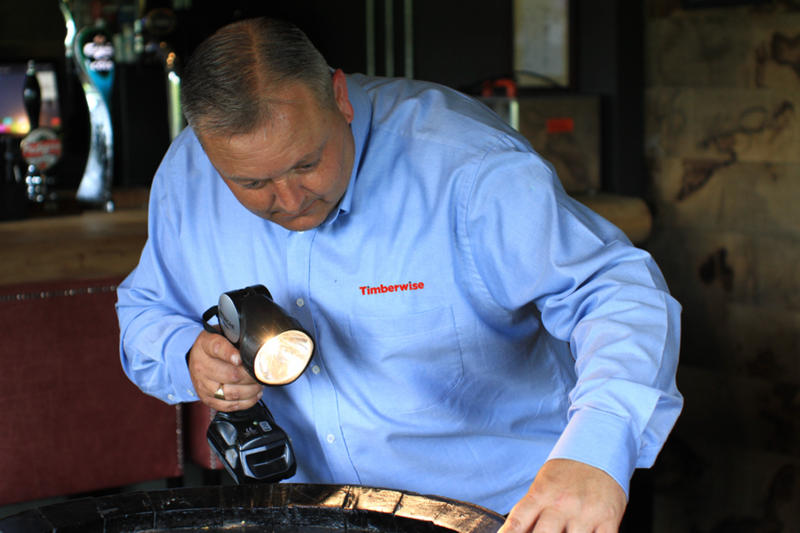A woodworm is, in fact, not a worm but the larva of a wood boring beetle. Woodworm season is typically March through to October, as this is when the adult beetles emerge from hibernation looking for a mate.
A larva of a wood eating beetle can penetrate any wooden structure. Woodworms are particularly attracted to timber with a higher moisture content as the moisture makes it easier for them to chew. So, if your property is prone to damp, there is a higher risk that you may get woodworm.

Signs of woodworm
The most obvious sign of woodworm affecting your property is visible holes, or ‘exit signs’ on timber, such as on loft beams or in floorboards.
When looking out for signs of woodworm, Timberwise,a leading property care expert and Which? Trusted Trader, says ‘to look for new bright holes in the timber with fresh tracks or piles of frass (which looks like sawdust). Holes will vary in size depending on the species of the wood borer, the most common being Anobium punctatum, or common furniture beetle, found in 75% of properties. The holes will be round, between 1-2mm in diameter. But for other wood borers it can be 15mm’.
Any timber that has been affected may also show visible damage and it might look similar to the damage caused by rot. See our article on getting rid of damp for how to spot signs of rot.
If caught early enough, it’s possible to get rid of woodworm with a shop-bought treatment. Timberwise suggested the following remedial action:
‘Take pictures of the holes and make a mental note of the number. You’re likely to see ongoing activity in the area you have treated as the treatment will not penetrate through the depth of the timber, but the beetle has to emerge to reproduce in most species and will come in contact with your treatment at that point. Monitor the areas adjacent to the treatments you’ve applied, and if you see new holes in other areas, then it’s time to call in the professionals.’
Fresh holes and fine dust known as frass indicate an active infestation. This can often affect the backs of wardrobes and other furniture. Picture Credit Peter Cox, a Which? Trusted Trader
Woodworm in furniture
It’s a common problem that if there’s woodworm in the property, it may well spread to your furniture. There are types of material that are more susceptible, so the first step is to establish if you have any of these in among your belongings. Items of furniture made of cherry, spruce, beech, birch and alder are particularly susceptible to woodworm but don’t forget to check other types of wood, either. The older your furniture is, the more likely there is to be woodworm – antique furniture, for example, can be especially appealing to woodworm.
The signs of woodworm in your furniture will be very similar to the signs in your home’s timber– small exit holes, evidence of frass and dead beetles around the suspected area.
How to treat woodworm in furniture
Unlike woodworm in a property’s timber, woodworm in furniture can be treated yourself.
Nicholas Donnithorne, technical services manager for Peter Cox, another Which? Trusted Trader who carries out woodworm surveys and treatments nationwide, said: ‘It’s not always easy to treat woodworm in furniture, particularly if it's hardwood. Treat with an insecticide fluid and always follow the instructions.’
Some other tips that may help you treat an infestation in your furniture include removing the item to an area where there is no other wood, removing all varnish or finishes before applying insecticide and ensuring all wood is covered when applying the treatment.
Depending on how bad the damage is, you may want to consider taking it to a restoration specialist, especially if the furniture is antique.
What to do if you suspect you have woodworm?
Preventative treatment
We asked damp, woodworm, rot and rising damp specialists Peter Cox if they had any advice on preventive treatment of woodworm and they said: ‘Keep all timber dry. If timber gets damp, more damage is likely. Check timber and furniture before bringing into the home. Ply bases to draws and backs of wardrobes should always be checked for damage.’
When asked for their number one tip when it comes to woodworm, Timberwise, pictured below, had the following advice:
‘Don’t panic. If you’re unsure of what you have, then seek advice from a professional. The majority of infestations can be treated successfully with very little disruption.’

There are a few tips we can give on the best ways to tackle woodworm. When it comes to woodworm, prevention is key, although this can be easier said than done. The main thing you can control is the humidity within your home.
Peter Cox says: ‘Woodworms generally prefer timber with a higher moisture level. By keeping your property well ventilated (and thus the timber within the property well ventilated), you’ll help to alleviate any further woodworm infestations.’
If you suspect your property has a woodworm infestation, the best thing to do is to call a professional. They will be able to identify if you have an active infection and the species of beetle that’s in your home, which will impact the best treatment to use to get rid of the infestation and prevent any further outbreaks.
Use Which? Trusted Traders to find a local woodworm specialist.
- Why choose Which? Trusted Traders
- More on pest control
